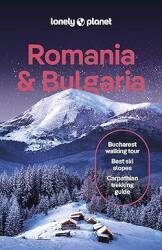
Thessaloniki — Sofia
Θεσσαλονίκη —
София
From Greece to Bulgaria by Train
Athens to Parisby Train
The next stage of our trip was from Thessaloniki, in northern Greece, to Sofia, in western Bulgaria. This is part of the Athens to Paris by Train series.
As soon as we arrived in Thessaloniki and got settled into our hotel, the Hotel Rex at 39 Ωδος Μονοστιριου, we returned to the station and bought our onward tickets. We had arrived in Thessaloniki at 18:31, and we had no problem at all buying tickets for the train leaving about thirty hours later, after midnight of the following evening. It was for train #462, leaving Thessaloniki at 0030 and arriving in Sofia at 0805.
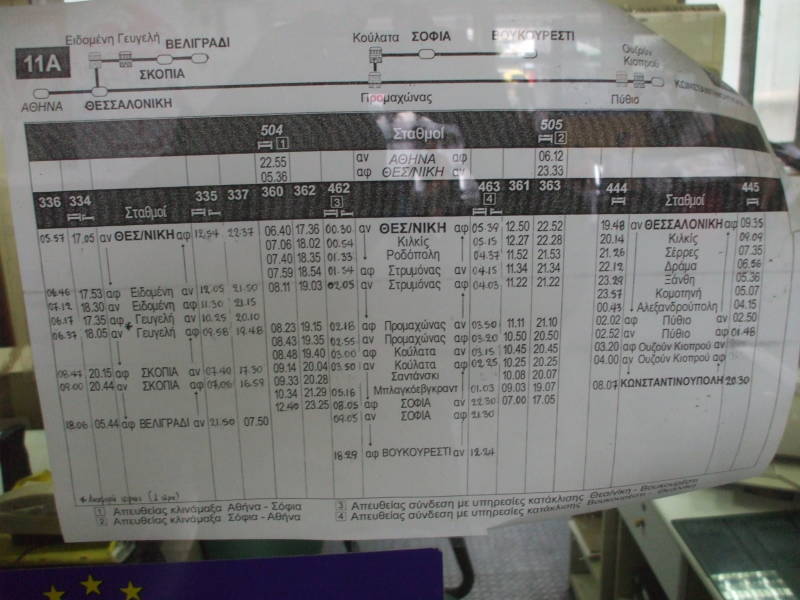
Could you count on getting a ticket to depart that same night? Maybe you could have, but the question became irrelevant.
Greece ceased all international rail operations. That's right — because their economy is such a wreck, they decided that the best possible move would be to cut themselves off from Europe. This would, of course, just make things far worse. And that will be blamed on the rest of Europe and the U.S. The rail connection to Sofia was shut down in February, 2011. You will see below that it was a Bulgarian train, the only Greek involvement was operating the locomotive between Thessaloniki and the border. But even that plus selling the tickets was too much trouble.
Only Greece would do such a thing.
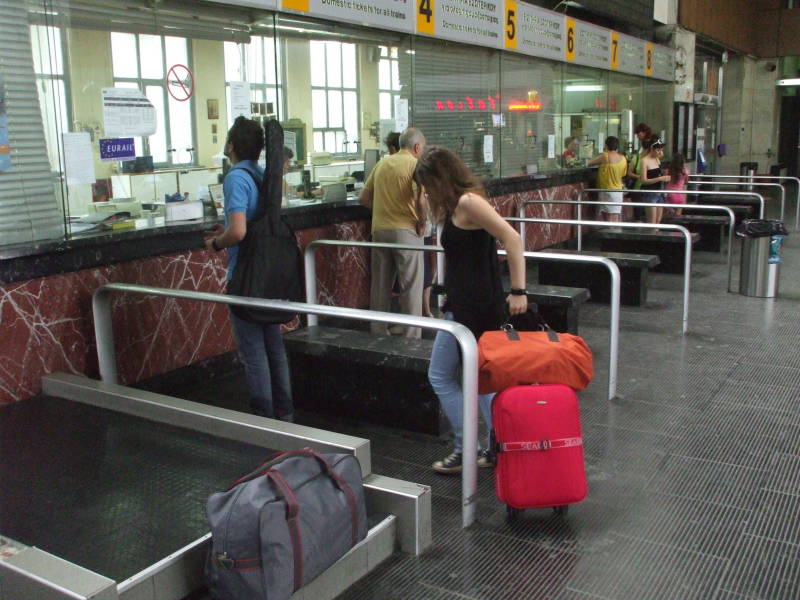
Service was discontinued from February 2011 through May 2014 when it was re-established. On May 10, 2014, Trainose restarted service with one daytime train per day from Thessaloniki to Sofia (6 hours, 50 minutes) and an overnight train with couchette and sleeping cars to Belgrade taking 12 hours and 41 minutes.
The above picture shows the schedules for international trains to and from Thessaloniki as posted in the station at the time of our trip. The schedule on the left side of the sheet is to and from Belgrade by way of Skopje, Macedonia (two trains each way, one a sleeper; the one on the right side is to and from İstanbul, which the Greeks insist on calling Constantinople (one train, overnight westbound); and the center one is to and from Sofia, Bulgaria (three trains each way daily, one a sleeper) continuing on to Bucharest, Romania. Click on the image for a larger version, or see the below table for the schedule of the northbound overnight train to Sofia.
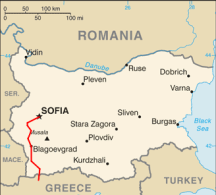

In red: The rail route from Thessaloniki, Greece to Sofia, Bulgaria.
These two maps show the general route for the train through Greece and Bulgaria.
Here is the schedule for the northbound overnight train.
| 0030 dep | Θεσσαλονίκη | Thessaloniki |

|
| 0054 | Κιλκίς | Kilkis | |
| 0133 | Ροδόπολη | Rodopoli | |
| 0205 | Στρυμόνας | Strimonas | |
| 0218 arr 0255 dep |
Προμαχώνας | Promahonas | |
| Greece–Bulgaria border | |||
| 0300 arr 0350 dep |
Кулата | Kulata |

|
| Сандански | Sandanski | ||
| 0516 | Благоевград | Blagoevgrad | |
| 0805 arr | София | Sofia | |
The map below shows the border crossing area. The map is based on data from the 1940s, before there was a rail connection here.
The last station before the border crossing, Strimonas, is somewhere around the bridge across the river Strimon Potamos, probably serving the town labeled on this map as Neon Petritsi.
A minor road is shown running north along the east bank of the river, the rail line must follow that. Προμαχώνας, labeled on this map as Promakhon, appears just south of the border. The train stops there for a scheduled 37 minutes for the Greek side of the border formalities, then it crosses the border to Кулата (Kulata) for a scheduled 50 minutes for the more involved and careful Bulgarian entry formalities.
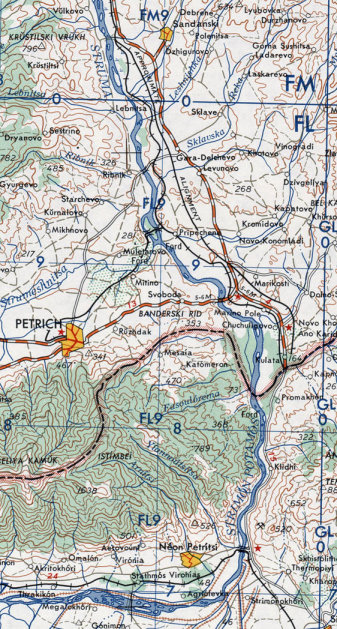

There is a chapel inside the Thessaloniki station. The Athens station didn't have one, or at least none this prominent.
Let's board our train and find our compartment!
This is a Bulgarian sleeper car: Спаленвагон, Spalenvagon or "sleeping wagon".
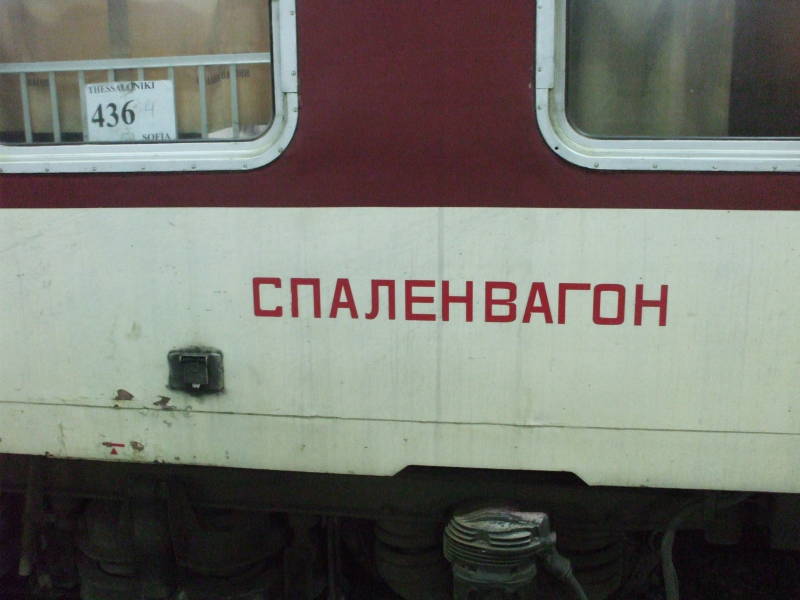
БДЖ, Български Държавни Железници (or Balgarski Darzhavni Zheleznitsi), is the Bulgarian state railroad company. This is definitely a Bulgarian train with an all Bulgarian staff, with the exception of the locomotive and its crew for just the two and a half hours between Thessaloniki and the border.
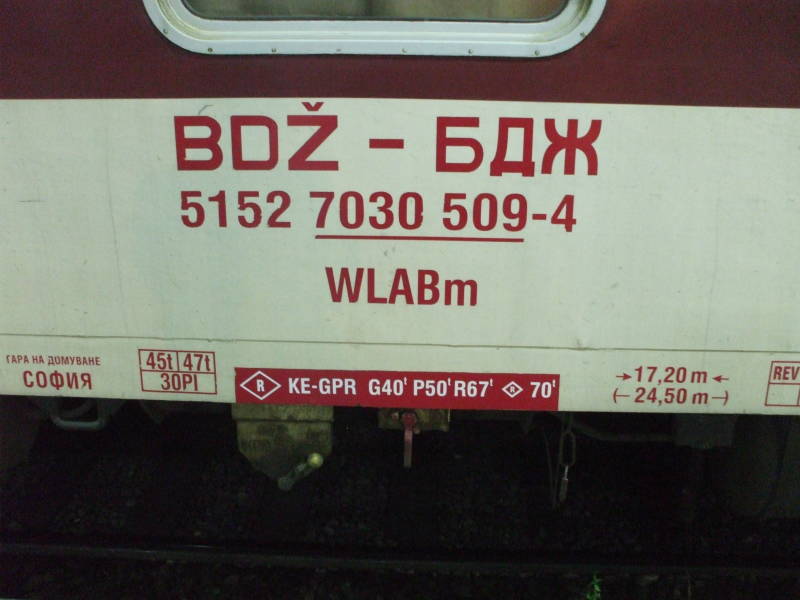
Our train had left Sofia at 2130 the night before, arriving in Thessaloniki at 0539 and sitting at the station through the day. It was pushed back on one of the sidings and into the weeds so that it wasn't obvious the next day that it would be the train running that night.
At the time of our trip, there were two non-sleeper trains in each direction each day: 0640-1240 and 1736-2325 northbound, and 0700-1250 and 1705-2252 southbound. The sleepers connect on between Sofia and Bucharest. A later stage of our trip had us joining that Thessaloniki — Sofia — Bucharest run in central Bulgaria and continuing to Bucharest.
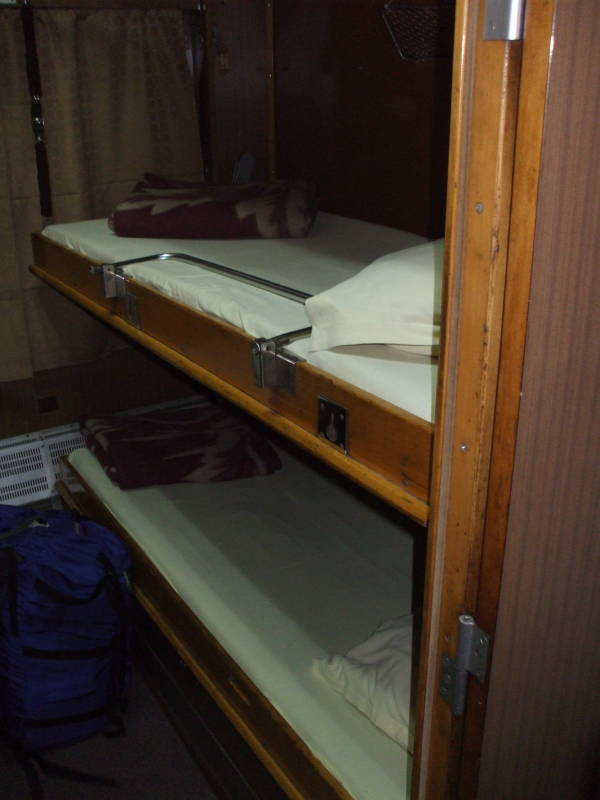
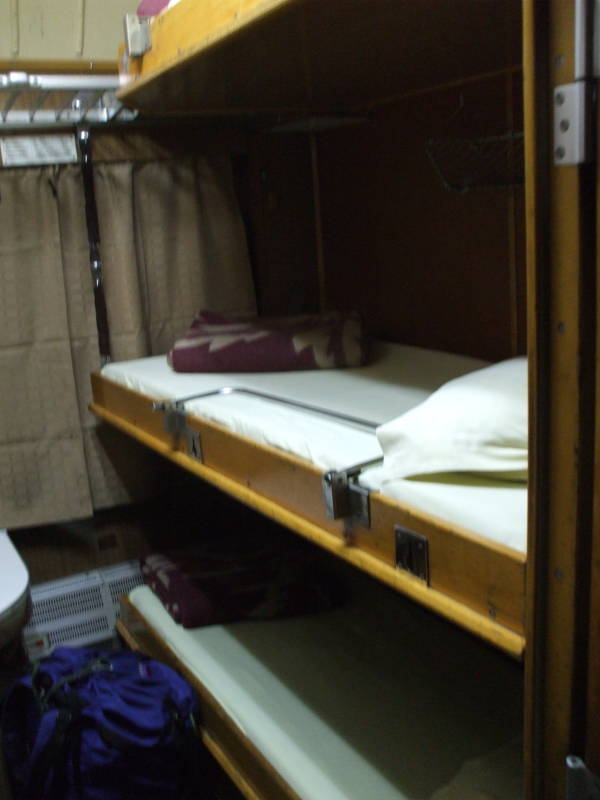
The sleeper compartments have three bunks or berths. In order to give my parents their own compartment, at the station in Thessaloniki I bought sleeper tickets for just two people.
Once we had those tickets in hand I said "Oh, and while I'm here, I need to buy one more ticket for just one person."
The exasperated ticket agent scolded me for not buying all three at once. You see, that would have made her work a little easier — one three-person ticket instead of having to complete two ticket transactions — and it would have cost a little less overall.
Yes, the Greek national railroad prefers that you arrange your travel so it means a little less work and less national revenue.
My apologies to the Greek national railroad for being a lucrative inconvenience.
This is the one segment of the trip for which I don't have notes on the exact cost. The attendant collected our tickets and did not return them at the far end as usually happens. However, I think it was about €50 for a two-person compartment and €40 for a one-person compartment. And, I think it would have been about €60 for all three in one compartment. That would have been just two-thirds the cost to us and two-thirds the revenue for the railroad, and the ticket agent could have avoided filling out that second ticket.
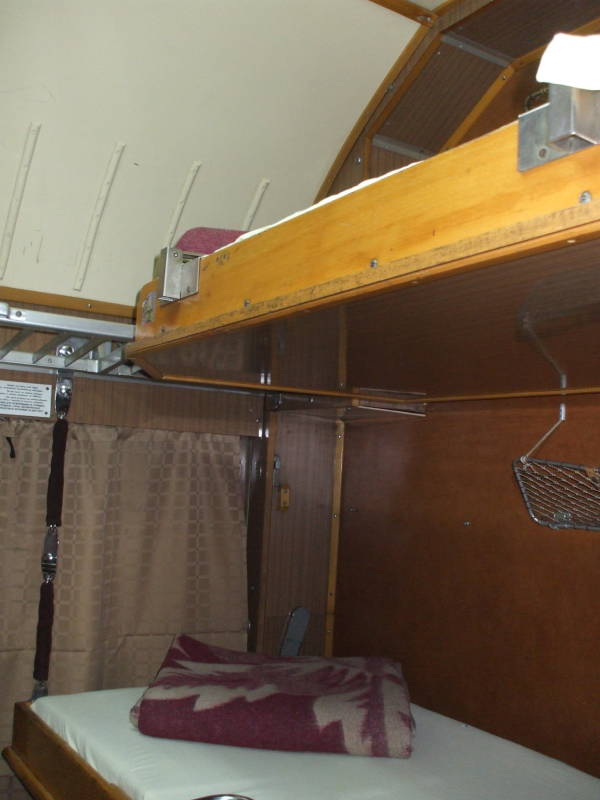
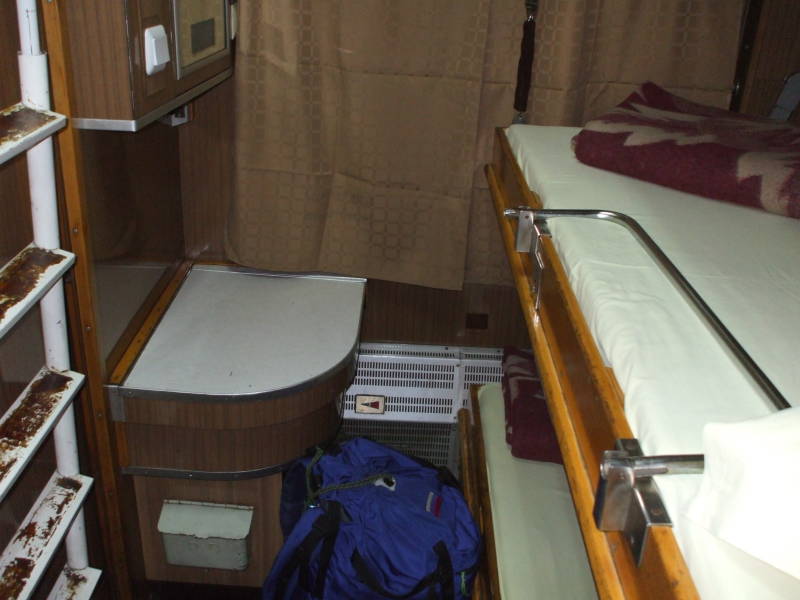
Anyway, the compartments are quite nice. Especially so if you bought a single ticket and end up in a compartment by yourself.
But even if you're sharing with two strangers, these types of compartments are nice for an overnight ride. I've ridden in compartments like this in Turkey, Russia, Estonia, and Poland, they're standard in eastern Europe.
The bunks are spaced fairly closely, you can't sit up in one when they are folded down. The top bunk is up against the curved ceiling following the exterior shape of the car. Luggage can be stored above the passageway in a similarly curved space.
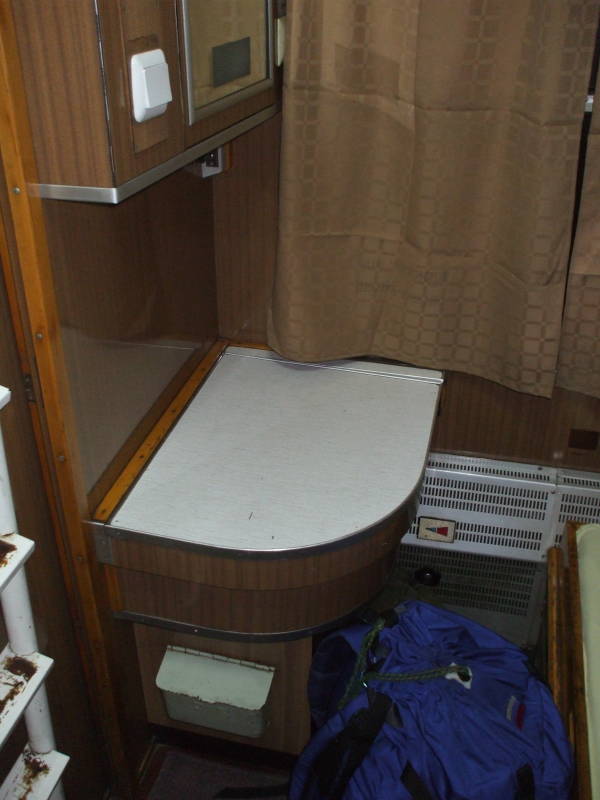
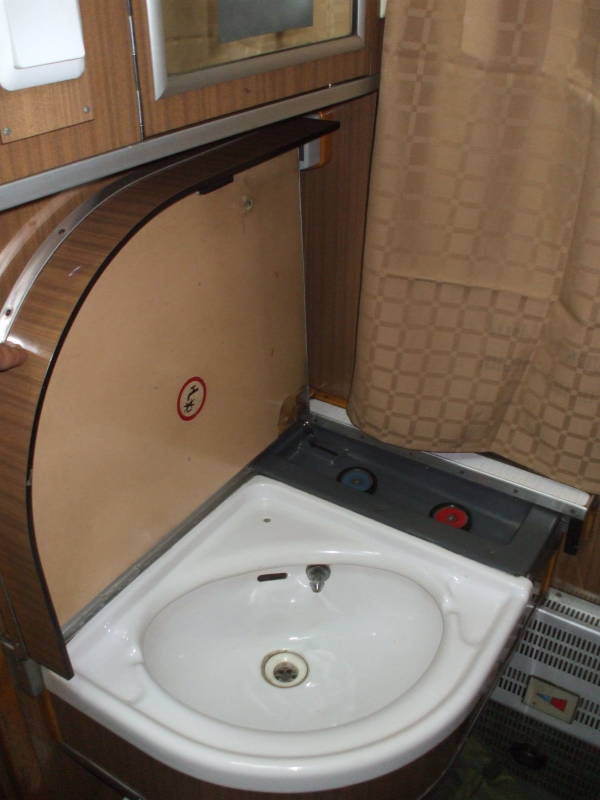
A sort of small desk or counter in one corner by the window contains a wash basin. The water in these types of cars is always non-potable, see the "no drinking" icon underneath the cover. Bring your own drinking water, but it's nice to have a wash basin in the compartment.
The signs are in a variety of European languages: German, French, Italian, and Russian, the last of those adamantly all upper case.
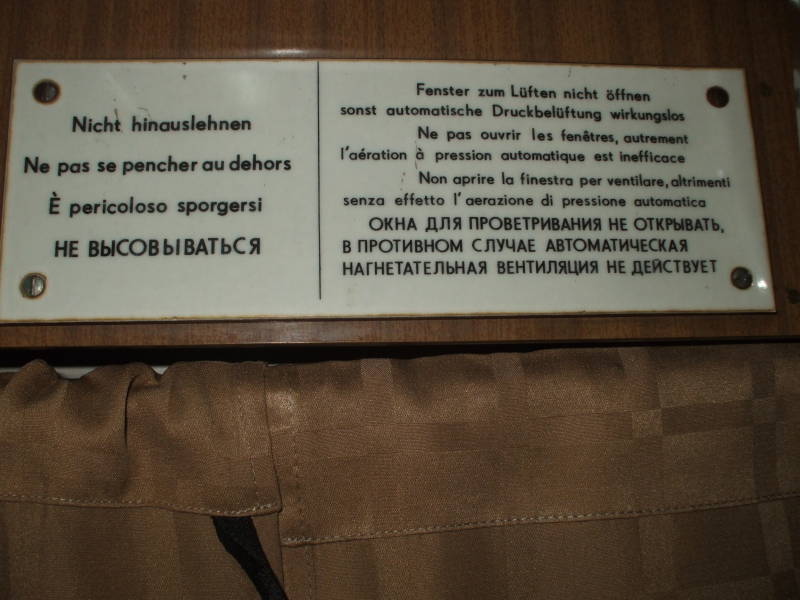
DO NOT LEAN OUT.
DO NOT OPEN THE WINDOWS, AS THAT MAKES THE AUTOMATIC VENTILATION INEFFICIENT.
EXPECT NO ENGLISH.

Others are in German and Bulgarian only.
You can easily figure out the light switches through experimentation. There are bright and dim overhead lights. And no, there is no button to summon the attendant. Go down the corridor to his compartment and knock.
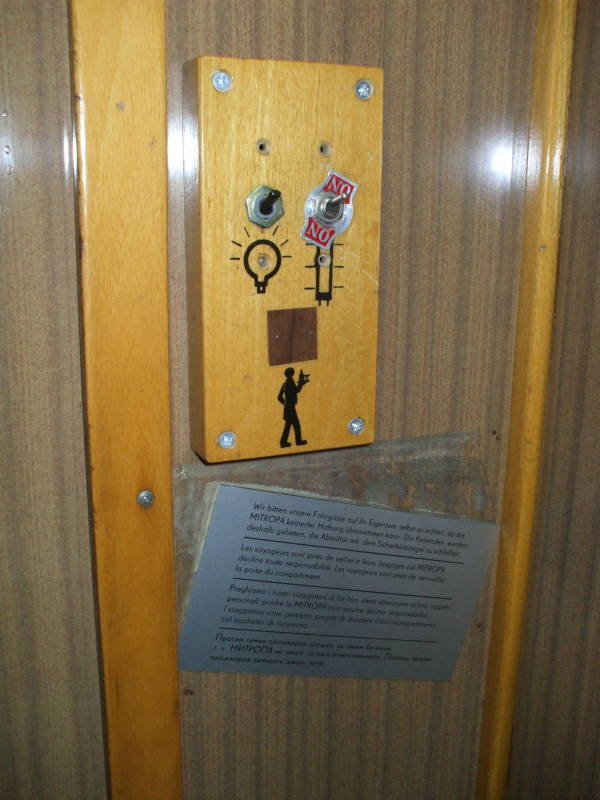
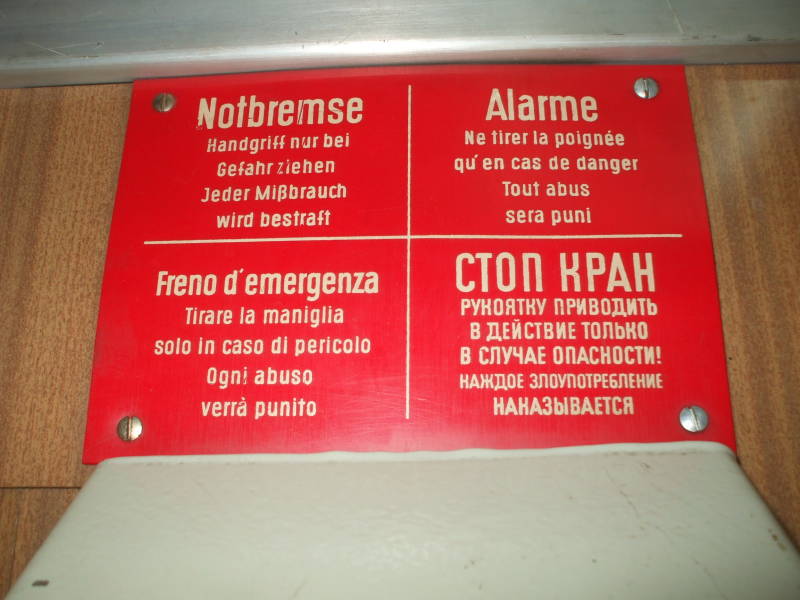
Hopefully you can figure out the bright red sign about not pulling the emergency lever unless it really is an emergency. But in German, French, Italian and Russian we are told:
EMERGENCY STOP
Pull the handle only in case of danger. Any abuse will be punished.
The berths all have crisp, clean linen. There is a small reading light in each one.
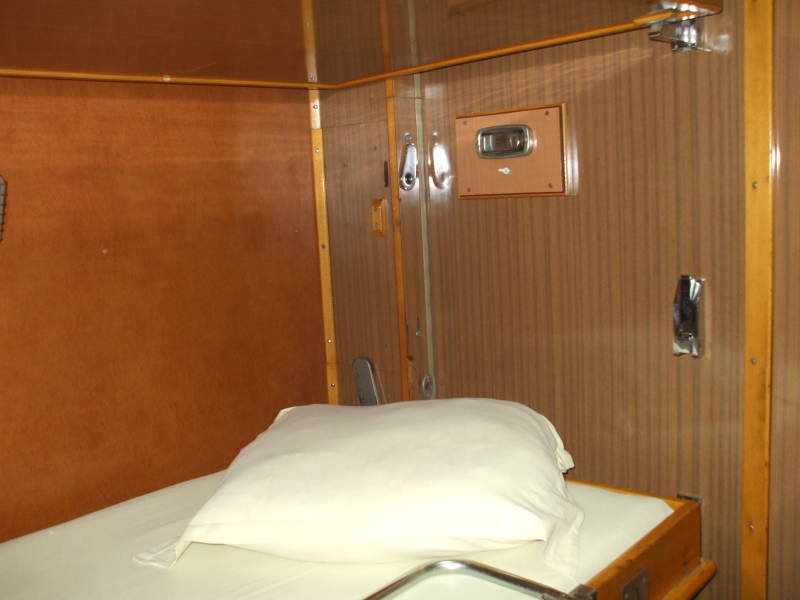
The rail folds up to keep you in bed even during sharp braking and acceleration.
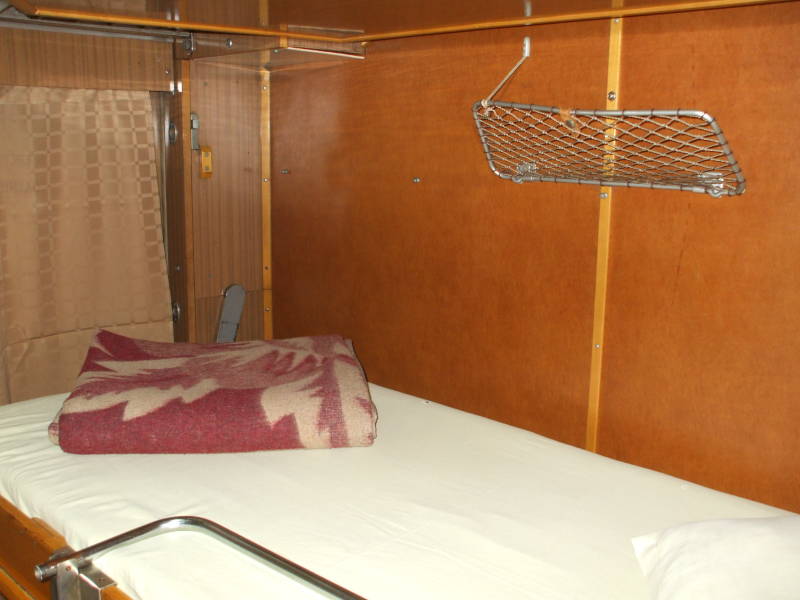
A small rack and net lets you store items right next to your bed.
Yes, there are toilets on board, at the end of the car. They aren't great, they are train toilets after all, but they aren't bad.

See my Toilet Guru site for the full range of international train toilets.
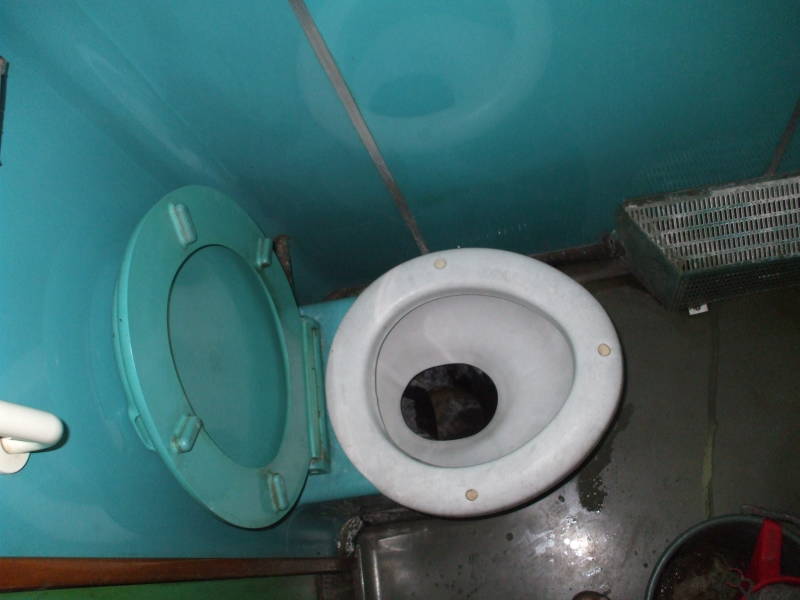
You don't see right out the bottom to where the cross-ties are whizzing past, but you are still asked not to use the toilets when the train is in a station.
The washbasin in the toilet compartment also has non-potable water. There is an outlet suitable for running an electric razor.
And look — a full roll of toilet paper and wax paper toilet seat covers! Compared to Russian train toilets, these are quite nice.
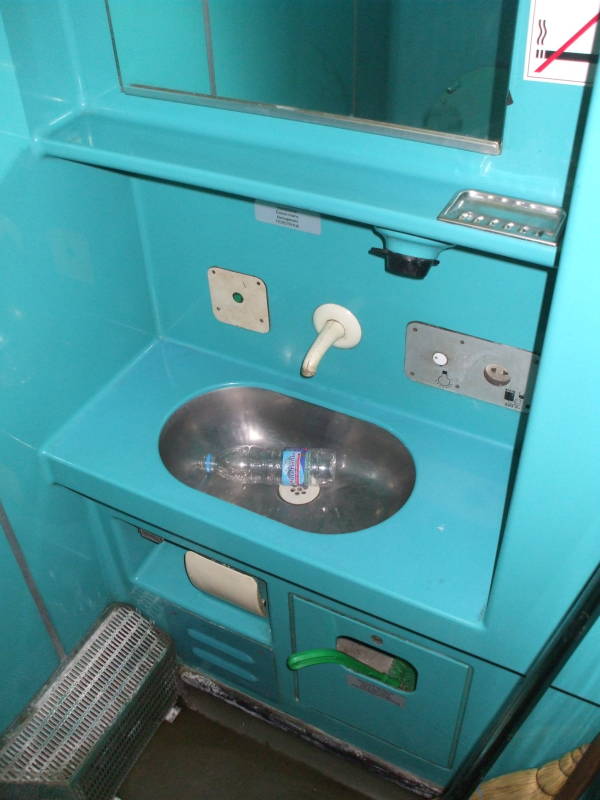
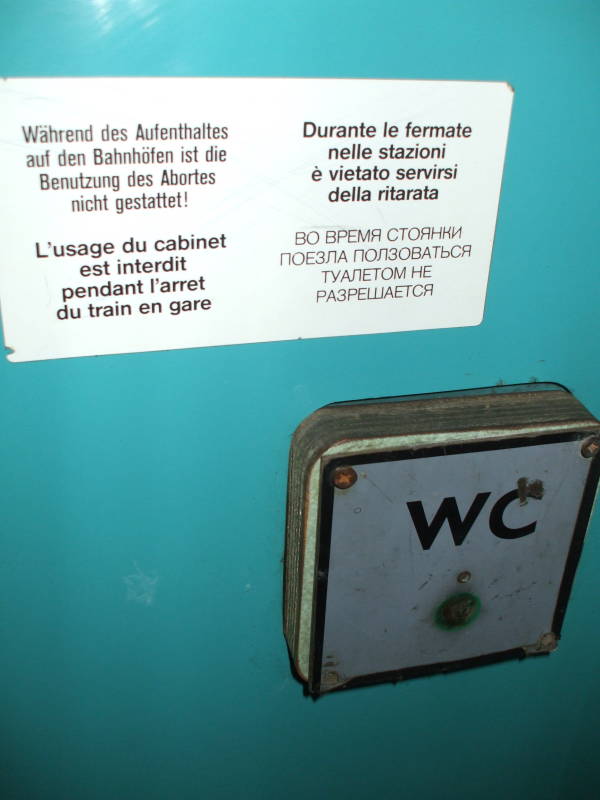
As it says in four languages, German, Italian, French and Russian:
DO NOT USE THE TOILET WHEN THE TRAIN IS IN THE STATION.
We got settled in for the first part of the night. Around 0230 the first wave of border guards knock on the compartment doors. You go through the Greek outbound customs, and then the Bulgarian entry work. They return your passports and you can turn off the light and go back to sleep about 0330.
In the night you ride north through southwestern Bulgaria, following the Struma River close to the border with Macedonia. You pass through Sandanski and stop in Blagoevgrad at 0516, then continue north through Stanke Dimitrov.
In the morning you enter the outskirts of Sofia, arriving there at its main train station at 0805.
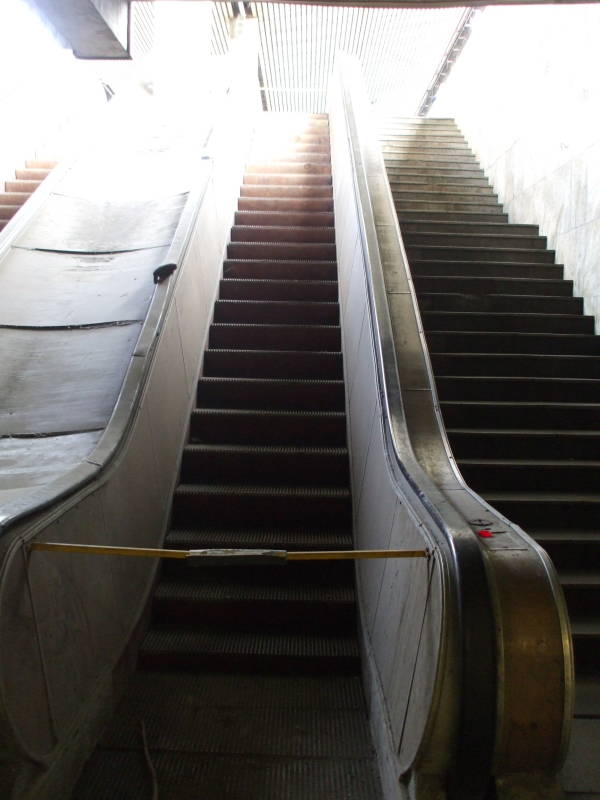

Some of the escalators at Sofia's main station are frozen in place and inoperative. This is just like in the main train station and much of the subway system in the U.S. capital!
Here we have entered the main hall of the station. Shifty characters mutter offers of unlicensed taxi rides through a haze of alcohol fumes. Again, as a frequent visitor to Washington, D.C., this seems quite familiar!
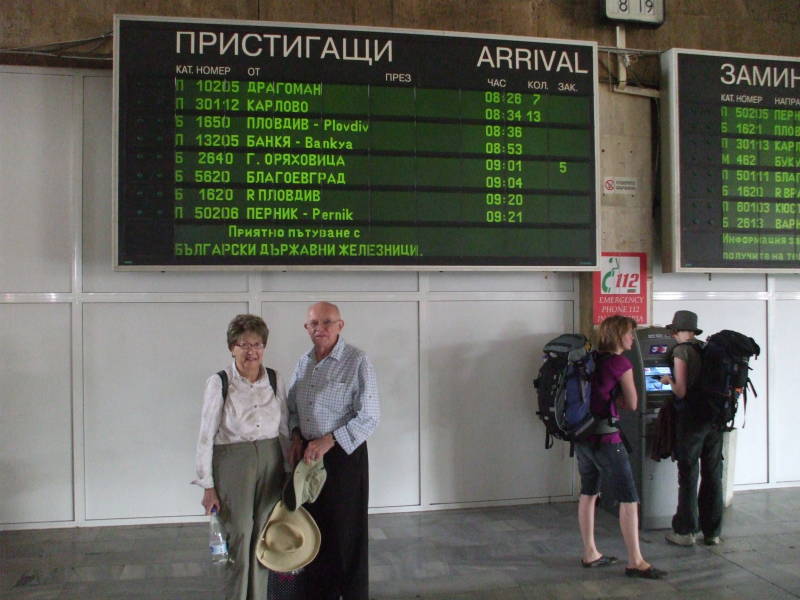
We have arrived in Sofia!
The train on which we arrived will sit in the Sofia station for about an hour. Then it will continue east across Bulgaria and then turn north toward Bucharest, Romania. In a few days we will join that train in central Bulgaria, but first we will visit both Sofia and Veliko Tarnovo.
We stayed at the Be My Guest hostel:
13 Улица
Иван
Вазов
voice +359-2-989-50-92, +359-2-980-21-42
fax +359-2-989-00-92
bemyguest@abv.bg
Back to the International Travel Recommendations

